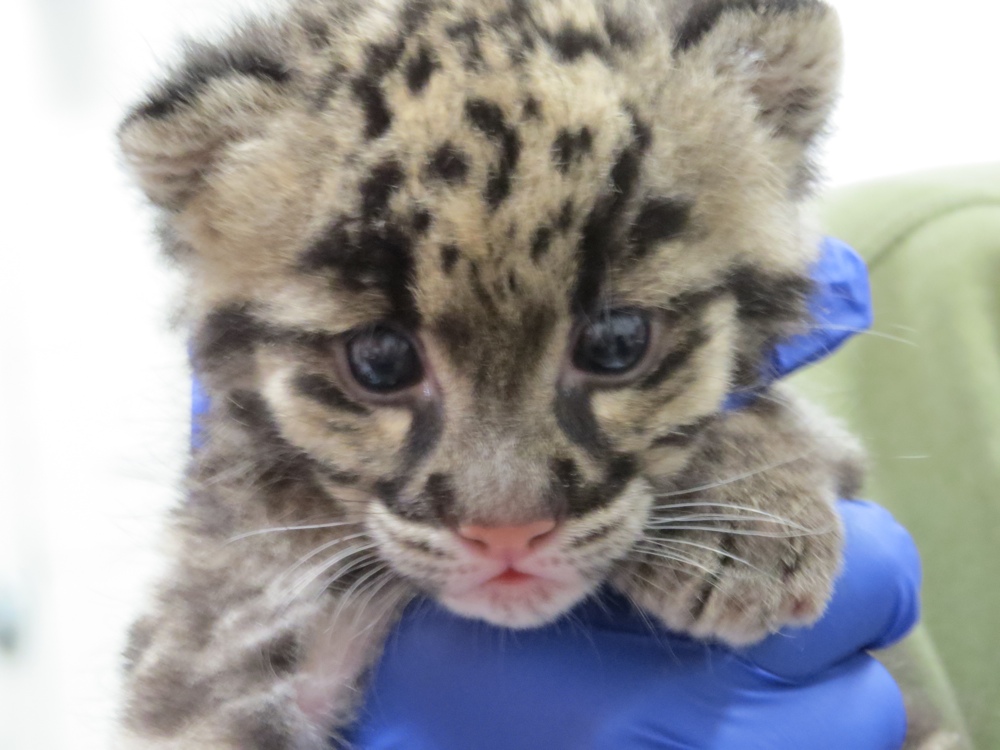Rare Clouded Leopard Cub Welcomed to Denver Zoo

What could be better than two tiny leopard cubs? Three tiny leopard cubs, of course!
At least, that's the attitude of administrators at Denver Zoo, who welcomed the addition of a female, clouded leopard cub to join the zoo's two existing cubs of the same species on Saturday (May 17). Zookeepers hope this addition will increase the chances that these rare cats will one day breed successfully.
The as yet unnamed female was born on April 10 at the Smithsonian Conservation Biology Institute (SCBI), a veterinary and reproductive research center in Front Royal, Virginia. The new cub joined a male, clouded leopard cub named Pi, and a female named Rhu, both born at the Denver Zoo on March 14.
Despite their name, these clouded leopard cubs are not actually leopards at all. They belong to their own genus, Neofelis, and are considered a bridge species between typical big cats (like lions and tigers) and small cats (like pumas, lynx and ocelots). The clouded leopard cubs living at Denver Zoo will grow to between two to four feet long and will likely weigh between 24 to 50 pounds. As to the celestial part of their name, the cats have distinctive, cloud-shaped blotches on their coats, which provide excellent camouflage in their native forest habitat. [See Images of Amur Leopard Mama and Cubs]
The new cub arrived at Denver Zoo through a recommendation of the Association of Zoos and Aquariums (AZA) Species Survival Plan, which promotes healthy populations, as well as genetic diversity, among zoo animals.
"This move is critically important to ensuring the long-term success of this species," said Rebecca McCloskey, Denver Zoo's assistant curator of Toyota Elephant Passage (the exhibit in which the cubs are housed). "We have learned that cubs must socialize with other cubs at an early age in order to be receptive to breeding as adults. With few cubs in zoos, this is a very important step to ensuring a stable long-term population."
And clouded leopards aren't just rare fixtures at zoos; they're also increasingly hard to find in the wild. While there are no reliable estimates for wild, clouded leopard populations, experts believe that their numbers are diminishing. The International Union for Conservation of Nature classifies the species as "vulnerable."
Get the world’s most fascinating discoveries delivered straight to your inbox.
This vulnerable status is believed to reflect the deforestation of the cats' natural habitat in Southeast Asia. Primarily found in southern China, Nepal, India, Burma, the Indochinese peninsula and the islands of Sumatra and Borneo, clouded leopards are also hunted for their pelts, as well as their bones, claws and teeth, which are used in traditional Asian medicines.
Denver Zoo's decision to adopt a third clouded leopard cub stems in part from its participation in field conservation projects for the species in Malaysia, as well as its work with zoos in Thailand, which hope to breed the cats in captivity for reintroduction to the wild.
It has yet to be determined whether the new female cub at Denver Zoo will be matched to breed with Pi, the zoo's only male clouded leopard cub. For now, zookeepers are focusing on socializing the newborn cubs and promoting their healthy development.
Follow Elizabeth Palermo on Twitter @techEpalermo, Facebook or Google+. Follow Live Science @livescience. We're also on Facebook & Google+. Originally published on Live Science.
 Live Science Plus
Live Science Plus





